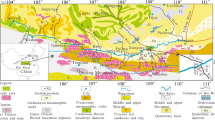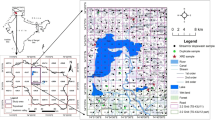Abstract
Aeolian sediments and other surface deposits are widespread along the broad valleys across the Yarlung Tsangpo (YT) catchment on the southern Tibetan Plateau (TP) and are considered important sources of global dust. However, geochemical differentiation in different reaches, sedimentary circulation, and dust transmission processes in the YT valleys are poorly understood. In this study, 47 samples of different types of sediments were collected from different YT valleys, and the major and trace-element (excluding rare-earth elements, REEs) compositions of 42 bulk samples and the trace elements (including REEs) compositions for the fine (< 75 μm) fractions of 21 samples were determined. The results show that the different sediments are predominantly sourced from local felsic bedrocks, originating mainly from the Lhasa terrane through the tributary systems, which are primarily controlled by the physical weathering, and only incipient chemical weathering. The geochemical characteristics of the various sediment types exhibited spatial differentiation because of the complex structure and topography, intense surface circulation, and mixing processes of the detritus from both banks. Owing to the complexity of regional surface processes, conventional non-isotopic geochemical methods might not be the most effective tool for sediment provenance tracing on a large spatial scale. Nevertheless, aeolian deposits in the broad valleys across YT mainly have a near-source clastic supply of local origins, belonging to a regional self-cycling process, which might not be transported by wind across different reaches because of high topographic obstacles.







source rocks of the sediments of the Yarlung Tsangpo (YT) catchment. The mixing curve in a connecting a granite end member to an ultramafic end member is derived from Amorosi et al. (2002), and the percentages listed in the plot are the percentage of ultramafic components in the samples. The trend arrows in b are according to McLennan et al. (1993) and Hu and Yang, (2016)



Similar content being viewed by others
References
Amorosi A, Centineo MC, Dinelli E et al (2002) Geochemical and mineralogical variations as indicators of provenance changes in Late Quaternary deposits of SE Po Plain. Sediment Geol 151(3):273–292
Bird BW, Polisar PJ, Lei YB et al (2014) A Tibetan lake sediment record of Holocene Indian summer monsoon variability. Earth Planet Sci Lett 399:92–102
Blatt H, Middleton G, Murray R (1972) Origin of sedimentary rocks. Prentice-Hall, Englewood Cliffs
Chen J, Ji JF, Qiu G et al (1998) Geochemical studies on the intensity of chemical weathering in Luochuan loess-paleosol sequence, China. Sci China (series D) 41(3):235–241
Ding ZL, Sun JM, Yang SL et al (2001) Geochemistry of the Pliocene red clay formation in the Chinese Loess Plateau and implications for its origin, source provenance and paleoclimate change. Geochim Cosmochim Acta 65(6):901–913
Dong ZB, Hu GY, Qian GQ et al (2017) High-altitude aeolian research on the Tibetan Plateau. Rev Geophys 55:1–38
Dong ZW, Brahney J, Kang SC et al (2020) Aeolian dust transport, cycle and influences in high-elevation cryosphere of the Tibetan Plateau region: New evidences from alpine snow and ice. Earth-Sci Rev 211:103408
Du SS, Wu YQ, Tan LH et al (2018) Geochemical characteristics of fine and coarse fractions of sediments in the Yarlung Zangbo River Basin (southern Tibet, China). Environ Earth Sci 77:336–347
Eltom HA, Abdullatif OM, Makkawi MH et al (2017) Rare earth element geochemistry of shallow carbonate outcropping strata in Saudi Arabia: application for depositional environments prediction. Sediment Geol 348:51–68
Fang XM, Han YX, Ma JH et al (2004) Dust storms and loess accumulation on the Tibet Plateau: a case study of the dust event on 4 March 2003 in Lhasa. Chinese Sci Bull 49(9):953–960
Fang XM, An ZS, Clemens SC et al (2020) The 3.6-Ma aridity and westerlies history over midlatitude Asia linked with global climatic cooling. Proc Natl Acad Sci USA 117(40):24729–24734
Fedo CM, Nesbitt HW, Young GM (1995) Unraveling the effects of potassium metasomatism in sedimentary rocksand paleosols, with implications for paleoweathering conditions and provenance. Geology 23(10):921–924
Hatano N, Yoshida K, Mori S et al (2020) Major element and REE compositions of Pliocene sediments in southwest Japan: implications for paleoweathering and paleoclimate. Sediment Geol 408:105751
Hu FG, Yang XP (2016) Geochemical and geomorphological evidence for the provenance of aeolian deposits in the Badain Jaran Desert, northwestern China. Quat Sci Rev 131:179–192
Immerzeel WW, van Beek LPH, Bierkens MFP (2010) Climate change will affect the Asian water towers. Science 328(5984):1382–1385
Jiang QD, Yang XP (2019) Sedimentological and geochemical composition of aeolian sediments in the Taklamakan desert: implications for provenance and sediment supply mechanisms. J Geophys Res-Earth 124:1217–1237
Jin HL, Dong GR, Zhang CL (2000) Deposition features and causes of loess in Yarlung Zangbo River Valley area. J Desert Res 20:14–19 (in Chinese with English abstract)
Klinge M, Lehmkuhl F (2015) Holocene aeolian mantles and inter-bedded paleosols on the southern Tibetan Plateau. Quat Int 372:33–44
Lehmkuhl F, Klinge M, Rees-Jones J et al (2000) Late Quaternary aeolian sedimentation in central and south- eastern Tibet. Quat Int 68–71:117–132
Li CL, Kang SC, Zhang QG et al (2009) Rare earth elements in the surface sediments of the Yarlung Tsangbo (Upper Brahmaputra River) sediments, southern Tibetan Plateau. Quat Int 208:151–157
Ling ZY, Yang SL, Wang X et al (2020a) Spatial-temporal differentiation of eolian sediments in the Yarlung Tsangpo catchment, Tibetan Plateau, and response to global climate change since the Last Glaciation. Geomorphology 357:1–12
Ling ZY, Yang XY, Wang YX et al (2020b) OSL chronology of Liena archeological site in the Yarlung Tsangpo valley throws new light on human occupation of the Tibetan Plateau. Holocene 30(7):1043–1052
Liu Q, Yang X (2018) Geochemical composition and provenance of aeolian sands in the Ordos Deserts, northern China. Geomorphology 318:354–374
Liu DW, Bertarand S, Villaseňor T et al (2020) Provenance of northwestern Patagonian river sediments (44–48°S): a critical evaluation of mineralogical, geochemical and isotopic tracers. Sediment Geol 408:105744
Mason BH, Moore CB (1982) Principles of geochemistry. Wiley, New York
Masuda A, Nakamura N, Tanaka T (1973) Fine structures of mutually normalized rare earth patterns of chondrites. Geochim Cosmochim Acta 37(2):239–248
McLennan SM, Hemming S, McDaniel DK et al (1993) Geochemical approaches to sedimentation, provenance, and tectonics. Geol Soc Am Spec Pap 284:21–40
Muhs DR (2004) Mineralogical maturity in dunefields of North America, Africa and Australia. Geomorphology 59:247–269
Muhs DR (2018) The geochemistry of loess: Asian and North American deposits compared. J Asian Earth Sci 155:81–115
Nesbitt HW, Young GM (1982) Early Proterozoic climates and plate motions inferred from major element chemistry of lutites. Nature 299:715–717
Nesbitt HW, Young GM (1989) Formation and diagenesis of weathering profiles. J Geol 97(2):129–147
Nie JS, Stevens T, Rittner M et al (2015) Loess Plateau storage of Northeastern Tibetan Plateau-derived Yellow River sediment. Nat Commun 6:1–10. https://doi.org/10.1038/ncomms9511
Parrington JR, Zoller WH, Aras NK (1983) Asian dust: seasonal transport to the Hawaiian Islands. Scicence 220:195–197. https://doi.org/10.1126/science.220.4593.195
Péwé TL, Liu TS, Slatt RM et al (1995) Origin and character of loess like silt in the southern Qinghai-Xizang (Tibet) Plateau, China. US Geol Surv Prof Pap 1549:1–55
Pullen A, Kapp P, McCallister AT et al (2011) Qaidam Basin and northern Tibetan Plateau as dust sources for the Chinese Loess Plateau and paleoclimatic implications. Geology 39(11):1031–1034
Qian YB, Wu ZN, Ishii T et al (1993) The constituent characteristics of sand materials and sand sources of the Taklamakan Desert. J Desert Res 13:32–38 (in Chinese with English abstract)
Rohrmann A, Heermance R, Kapp P et al (2013) Wind as the primary driver of erosion in the Qaidam Basin, China. Earth Planet Sci Lett 374:1–10
Rudnick RL, Gao S (2003) Composition of the continental crust. In: Holland HD, Turekian KK (eds) Treatise on geochemistry, vol 3. Elsevier, Amsterdam, pp 1–64
Smalley I, O’Hara-Dhand K, Wint J et al (2009) Rivers and loess: the significance of long river transportation in the complex eventsequence approach to loess deposit formation. Quat Int 198:7–18
Stauch G (2015) Geomorphological and paleoclimate dynamics recorded by the formation of aeolian archives on the Tibetan Plateau. Earth-Sci Rev 150:393–408
Stevens T, Carter A, Watson TP et al (2013) Genetic linkage between the Yellow River, the Mu Us desert and the Chinese Loess Plateau. Quat Sci Rev 78:355–368
Sun JM, Li SH, Muhs DR et al (2007) Loess sedimentation in Tibet: provenance, processes, and link with Quaternary glaciations. Quat Sci Rev 26:2265–2280
Taylor SR, McLennan SM (1985) The continental crust: its composition and evolution. Blackwell, Oxford
Wang AH, Wang ZH, Liu JK et al (2021) The Sr/Ba ratio response to salinity in clastic sediments of the Yangtze River Delta. Chem Geol 559:119923
Yang YS, Li BY, Yin ZS et al (1982) The formation and evolution of landforms in the Xizang Plateau. Acta Geogr Sin 37(1):76–87 (in Chinese with English abstract)
Zhang DD (1998) Geomorphological problems of the middle reaches of the Tsangpo river, Tibet. Earth Surf Proc Land 23:889–903
Zhang HZ, Zhou KS, Duojiesangzhu G et al (2018a) Analysis of spatiotemporal variation characteristics of wind–sand days in the Yarlung Zangbo river basin during 1981–2016. J Arid Land Resour Environ 32(12):131–136 (In Chinese with English abstract)
Zhang WF, Zhao JX, Chen J et al (2018b) Binary sources of Chinese loess as revealed by trace and REE element ratios. J Asian Earth Sci 166:80–88
Zhang WF, Wu JL, Zhan SE et al (2021) Environmental geochemical characteristics and the provenance of sediments in the catchment of lower reach of Yarlung Tsangpo river, southeast Tibetan Plateau. CATENA 200:105150
Zhao WC, Liu LW, Chen J et al (2019) Geochemical characterization of major elements in desert sediments and implications for the Chinese loess source. Sci China Earth Sci 62(9):1428–1440
Zheng D, Yao TD (2004) Progress in research on formation and evolution of Tibetan Plateau with its environment and resource effects. China Basic Sci 6(2):17–23 (In Chinese with English abstract)
Acknowledgements
This research was financially supported by the Second Tibetan Plateau Scientific Expedition and Research Program (STEP) (Grant nos. 2019QZKK0602 and 2019QZKK0805), National Natural Science Foundation of China (Grant no. U20A2088), Key Deployment Projects of the Chinese Academy of Sciences (Grant no. ZDRW-ZS-2020-3), and the Qinghai Provincial Science and Technology Innovation Platform (Grant no. 2020-ZJ-T03).
Author information
Authors and Affiliations
Corresponding author
Additional information
Publisher's Note
Springer Nature remains neutral with regard to jurisdictional claims in published maps and institutional affiliations.
Rights and permissions
About this article
Cite this article
Ling, Z., Li, J., Jin, J. et al. Geochemical characteristics and provenance of aeolian sediments in the Yarlung Tsangpo valley, Southern Tibetan Plateau. Environ Earth Sci 80, 623 (2021). https://doi.org/10.1007/s12665-021-09928-5
Received:
Accepted:
Published:
DOI: https://doi.org/10.1007/s12665-021-09928-5




